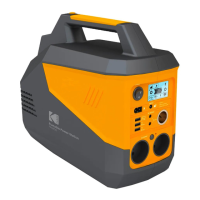4
Congratulations on purchasing KODAK Portable Power Station PPS800, a plug-and-play power supply for
outdoor use (IP32). With 756 watt-hours of stored energy, you can keep appliances, or electronic devices
running for hours.
The KODAK PPS800 Portable Power Station is designed to keep you powered up while travelling in your
RV, during emergencies involving power outages, or camping with the family at the lake.
Note the following points while reading through this instruction manual:
• This manual was prepared with care and to the best of our knowledge.
Contact us should you have any questions relating to the product.
• This manual may not be copied or duplicated, except for personal use.
Disclaimer
• Our company cannot be held liable for damages caused by ire, earthquake, use by a third party, other
accidents, intentional misconduct on the part of the customer, abuse or other abnormal conditions.
• Do not repair any damage to the AC plug or power supply on your own.
• The warranty covers all terms and conditions of the warranty. Contents that are not speciied in the
warranty terms and conditions are beyond our responsibility.
• Our company assumes no liability for damages caused by incorrect use or non-compliance with this
instruction manual.
• This instruction manual, as well as other language versions can be downloaded as a PDF ile on our
website: www.portable-power-stations.com.
• Intended use: Our product is not suitable to be used with equipment that relates to one‘s own per-
sonal safety or which relies heavily on electricity, such as medical devices, equipment for nuclear
facilities, the manufacture of air and spacecraft, etc. We therefore assume no liability for accidents
involving personal safety, ires or machine failures caused by using our product with the aforementi-
oned devices.
2. INTRODUCTION

